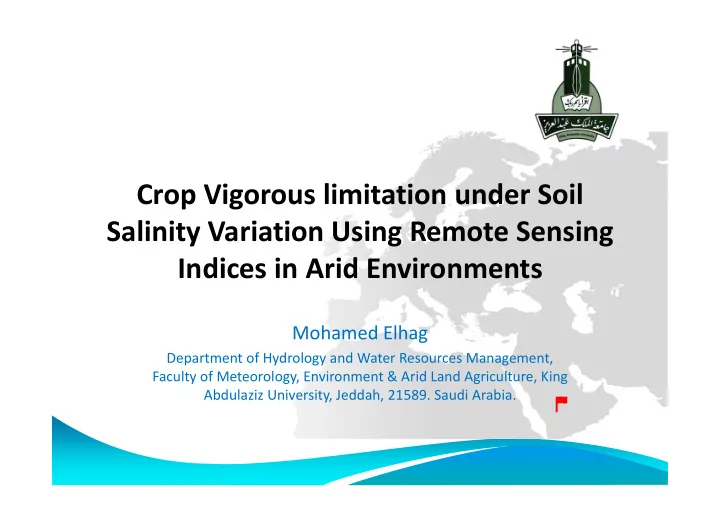

Crop Vigorous limitation under Soil Salinity Variation Using Remote Sensing Indices in Arid Environments Mohamed Elhag Department of Hydrology and Water Resources Management, Faculty of Meteorology, Environment & Arid Land Agriculture, King Abdulaziz University, Jeddah, 21589. Saudi Arabia.
Overview Introduction Objectives Study area Methodological framework Findings Conclusions
Introduction • Satellite images offer a large amount of data that could be analyzed Remote Sensing • Convenient source to perform several vegetation indices Data • Spectral reflectance variabilities tend to differentiate between different vegetation characteristics based on crop water relationships • Spectral vegetation indices are mathematical combinations of different spectral bands mostly in the visible and near ‐ infrared regions of the electromagnetic Spectral spectrum Vegetation Indices • Vegetation activities can be measured comprehensively through semi ‐ analytical methods of spectral band ratios
Introduction Excessive irrigation Soil Salinization Poor drainage
Objectives Spectral Vegetation Indices Soil Regression Salinity Analysis Indices Find the correlation between Soil Salinity indices and Hydrological Drought Indices Conservation of natural recourses
Study area Agriculture in Wadi Ad Dawasir area consists of technically highly developed farm enterprises that operate with modern pivot irrigation system. All year fodder consists of alfalfa, which is cut up to 10 times a year for food. The shallow alluvial aquifers could not sustain the high groundwater abstraction rates for a long time. The groundwater level declined The location of the study area in false dramatically in most areas from 120 to color composite almost 400 m deep.
Methodological framework Regression Analysis Estimation of soil salinity index Estimation of vegetation indices
Methodological framework • Water Supply Vegetation Index (WSVI) • Soil Adjusted Vegetation Index (SAVI) • Moisture Stress Index (MSI) Estimation of vegetation • Normalized Difference infrared Index (NDII) indices • Brightness Index • Normalized Difference Salinity Index • Salinity Index SI ‐ 6 Estimation of soil salinity • Salinity Index SI ‐ 9 index • Principle Component Analysis (PCA) • Artificial Neural Network (ANN) Regression Analysis
Soil Salinity Indices Hydrological Drought Indices Water Supply Vegetation Index (WSVI): Normalized Difference Salinity Index: Soil Salinity Soil Adjusted Vegetation Index (SAVI): Brightness Index: Salinity Index SI-6: Moisture Stress Index (MSI): WSVI SAVI MSI NDII Salinity Index SI-9: Normalized Difference Infrared Index (NDII): Artificial Neural Network (ANN)
Findings Water Supply Vegetation Index (WSVI) Soil Adjusted Vegetation Index (SAVI) Moisture Stress Index (MSI) Normalized Difference infrared Index (NDII)
Findings Normalized Difference Salinity Index Regression analyzes of NDSI (ppm) against hydrological drought indices
Findings Training Validation Measures Measures RSquare 0.7574526 0.6698156 RMSE 0.0999530 0.0972931 NDII Mean Abs Dev 0.0571881 0.0436599 ‐ LogLikelihood ‐ 88.411680 ‐ 45.554430 SSE 0.9990600 0.4732975 Sum Freq 100 50 RSquare 0.3032101 0.0893892 RMSE 0.2388872 0.1869959 Mean Abs Dev 0.1203075 0.0628425 MSI ‐ LogLikelihood ‐ 1.2825260 ‐ 12.886510 SSE 5.7067096 1.7483727 Principle Component Analysis Sum Freq 100 50 RSquare 0.7565419 0.6698155 RMSE 0.1499295 0.1459397 SAVI Mean Abs Dev 0.0857822 0.0654899 ‐ LogLikelihood ‐ 47.865170 ‐ 25.28115 SSE 2.2478847 1.0649203 Sum Freq 100 50 RSquare 0.7533827 0.6619429 RMSE 0.0003280 0.0003226 WSVI Mean Abs Dev 0.0001876 0.0001451 ‐ LogLikelihood ‐ 660.35100 ‐ 331.01460 SSE 1.08E ‐ 05 5.20E ‐ 06 Sum Freq 100 50 Neural Network Analysis
Conclusion & Recommendations Normalized Difference Infrared Principal Component Analysis Remote Sensing techniques were Index was statistically proved to and Artificial Neural Network satisfactorily implemented and be the Normalized Difference Analysis are complementary interpreted in term of soil Salinity Index profound, followed tools to understand the salinity mapping in consort with by Soil Adjusted Vegetation regression pattern of the hydrological drought indices Index and Water Shortage hydrological drought indices in Vegetation Index respectively the designated study area
Recommend
More recommend